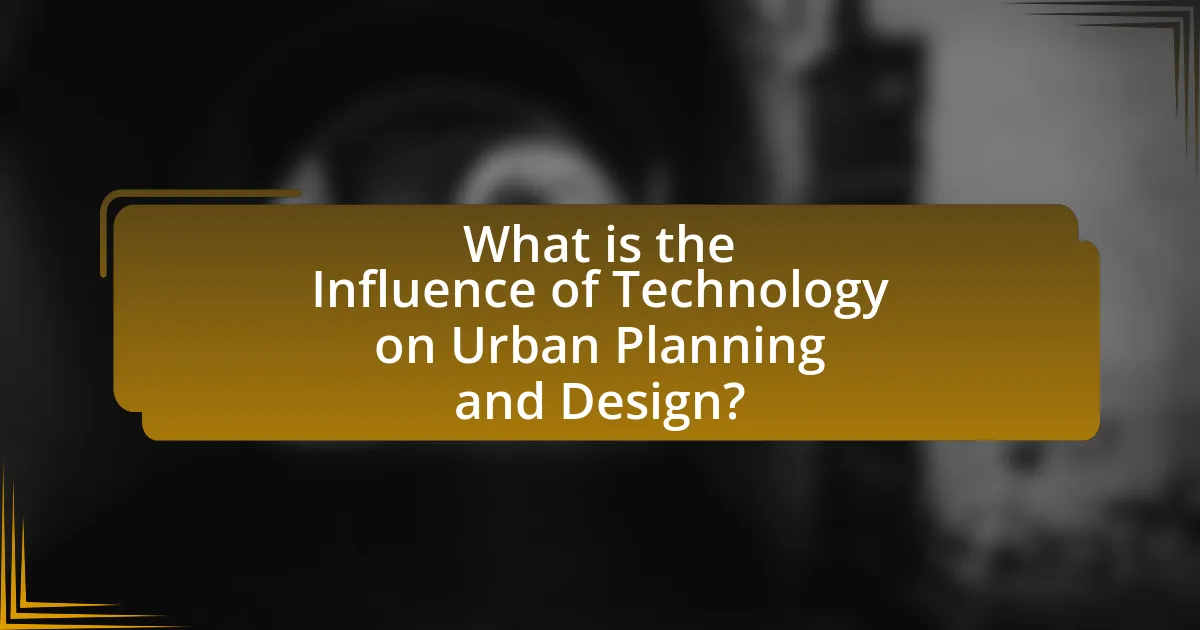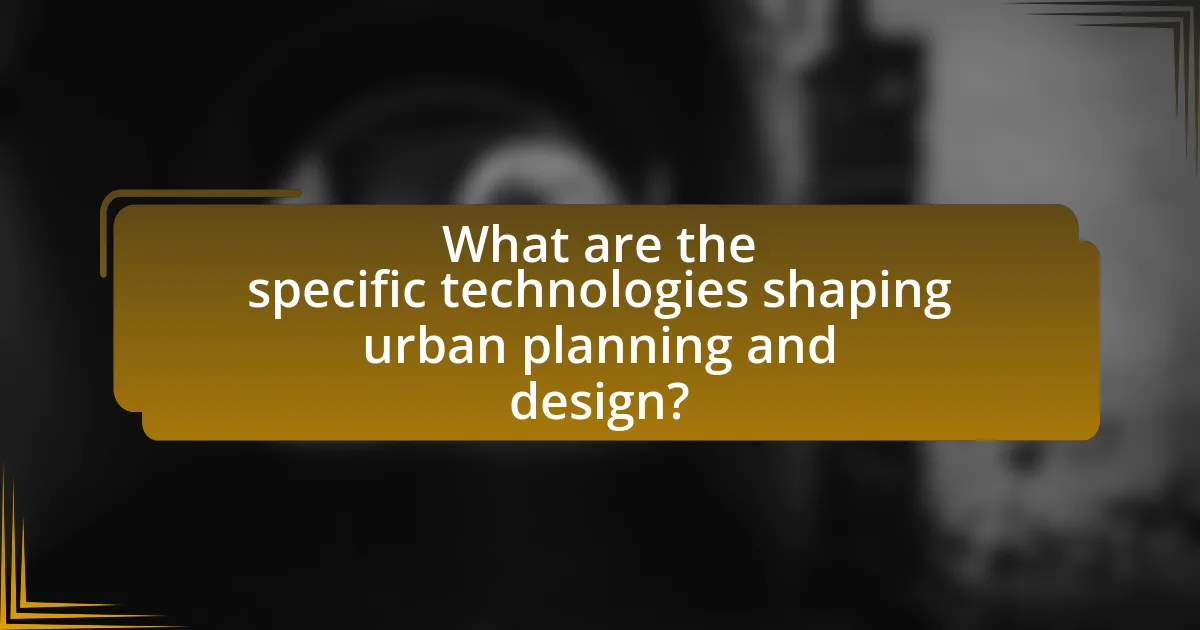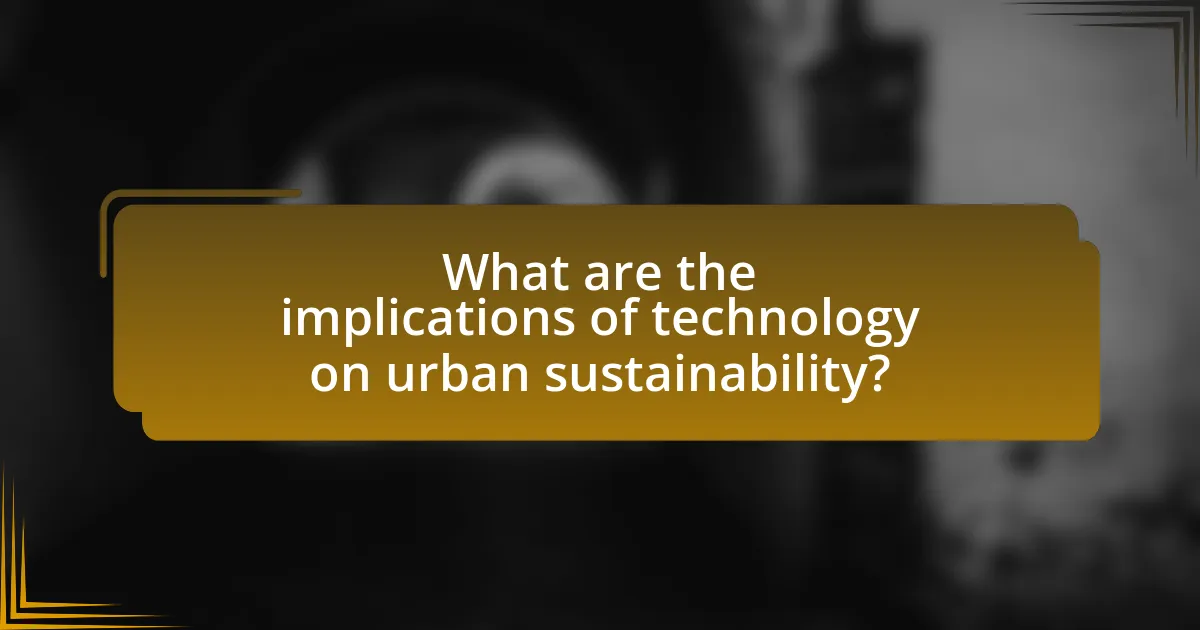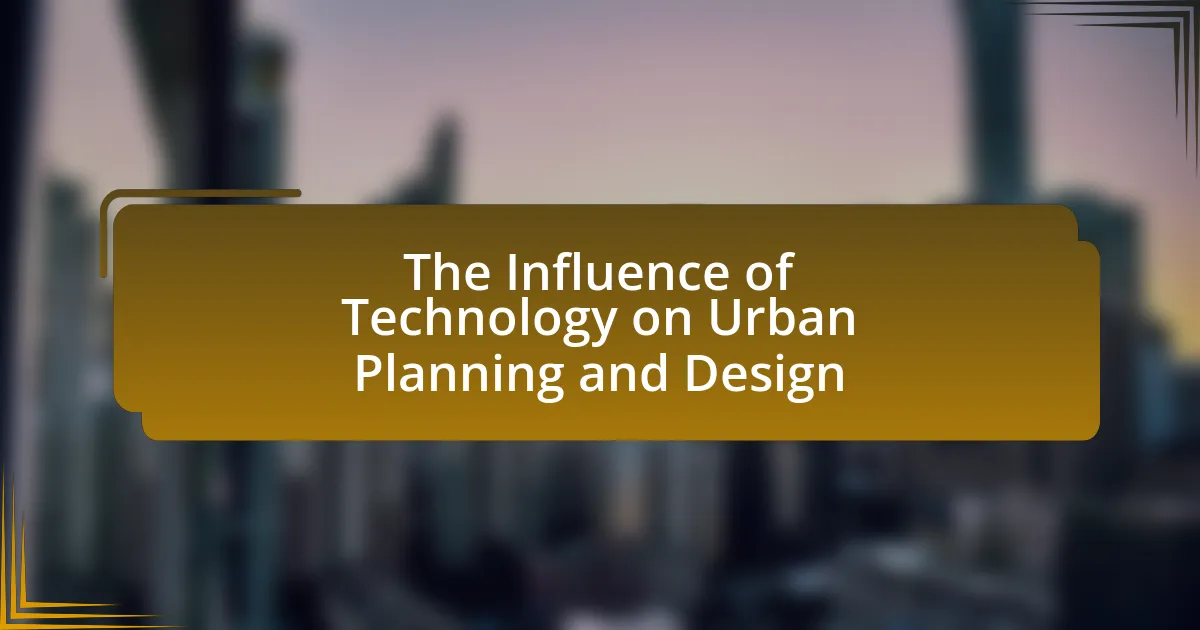The article examines the significant influence of technology on urban planning and design, highlighting advancements such as Geographic Information Systems (GIS), Building Information Modeling (BIM), and smart city technologies. It discusses how these technologies enhance data collection, analysis, and visualization, leading to improved decision-making and community engagement. The article also addresses the implications of technology for urban sustainability, efficiency, and resource management, while acknowledging potential challenges such as data privacy concerns and urban inequality. Overall, it emphasizes the transformative role of technology in creating responsive and adaptive urban environments.

What is the Influence of Technology on Urban Planning and Design?
Technology significantly influences urban planning and design by enhancing data collection, analysis, and visualization, which leads to more informed decision-making. For instance, Geographic Information Systems (GIS) allow urban planners to analyze spatial data effectively, enabling them to identify patterns and trends in land use, transportation, and demographics. Additionally, smart city technologies, such as IoT sensors, facilitate real-time monitoring of urban infrastructure, improving resource management and sustainability. According to a report by the McKinsey Global Institute, cities that adopt advanced technologies can improve their productivity by up to 30%, demonstrating the tangible benefits of integrating technology into urban planning processes.
How has technology transformed urban planning practices?
Technology has transformed urban planning practices by enabling data-driven decision-making and enhancing community engagement. Geographic Information Systems (GIS) allow planners to analyze spatial data, visualize urban layouts, and assess environmental impacts, leading to more informed planning decisions. Additionally, tools like Building Information Modeling (BIM) facilitate collaboration among stakeholders, improving project efficiency and reducing costs. The integration of smart technologies, such as IoT sensors, provides real-time data on traffic patterns and resource usage, allowing for adaptive management of urban infrastructure. These advancements have resulted in more sustainable, efficient, and responsive urban environments.
What are the key technological advancements impacting urban design?
Key technological advancements impacting urban design include smart city technologies, Geographic Information Systems (GIS), and Building Information Modeling (BIM). Smart city technologies utilize sensors and data analytics to enhance urban infrastructure and services, improving efficiency and sustainability. For instance, cities like Barcelona have implemented smart lighting and waste management systems that reduce energy consumption and optimize resource use. Geographic Information Systems enable planners to visualize and analyze spatial data, facilitating informed decision-making regarding land use and transportation. A study by the American Planning Association highlights that GIS improves urban planning outcomes by providing detailed demographic and environmental data. Building Information Modeling allows for the creation of digital representations of physical structures, enhancing collaboration among stakeholders and reducing construction costs. Research from McKinsey & Company indicates that BIM can decrease project delivery times by up to 30%. These advancements collectively transform urban design by promoting sustainability, efficiency, and collaboration.
How do these advancements change the role of urban planners?
Advancements in technology significantly change the role of urban planners by enhancing data analysis and decision-making processes. Urban planners now utilize Geographic Information Systems (GIS), big data analytics, and smart city technologies to assess urban environments more effectively. For instance, the integration of real-time data allows planners to monitor traffic patterns and environmental conditions, leading to more informed planning decisions. Additionally, tools like 3D modeling and simulation software enable planners to visualize projects and engage stakeholders more effectively, improving community involvement and feedback. These technological advancements ultimately shift urban planners from traditional roles focused on static plans to dynamic facilitators of adaptive, data-driven urban development.
Why is technology essential in modern urban design?
Technology is essential in modern urban design because it enhances efficiency, sustainability, and livability in urban environments. The integration of smart technologies, such as IoT sensors and data analytics, allows urban planners to optimize resource management, improve traffic flow, and reduce energy consumption. For instance, cities that implement smart traffic management systems can decrease congestion by up to 30%, as evidenced by studies conducted in cities like Los Angeles and Singapore. Additionally, technology facilitates community engagement through digital platforms, enabling residents to participate in the planning process, which leads to designs that better reflect the needs of the population. Thus, the application of technology in urban design not only streamlines processes but also fosters more responsive and adaptive urban environments.
What challenges in urban planning does technology address?
Technology addresses several challenges in urban planning, including data management, resource allocation, and community engagement. For instance, Geographic Information Systems (GIS) enable planners to analyze spatial data effectively, leading to informed decision-making regarding land use and infrastructure development. Additionally, smart city technologies facilitate real-time monitoring of urban systems, improving resource efficiency and reducing waste. Furthermore, digital platforms enhance community engagement by allowing residents to participate in planning processes through surveys and feedback tools, fostering transparency and inclusivity. These technological advancements collectively enhance the effectiveness and responsiveness of urban planning efforts.
How does technology enhance community engagement in urban planning?
Technology enhances community engagement in urban planning by facilitating real-time communication and feedback between planners and residents. Digital platforms, such as social media, mobile applications, and online surveys, allow community members to express their opinions and participate in decision-making processes more easily. For instance, cities like Boston have utilized the “Boston 311” app, enabling residents to report issues and provide input on urban projects, which has led to increased public participation and transparency in planning efforts. This integration of technology not only streamlines the engagement process but also ensures that diverse community voices are heard, ultimately leading to more inclusive and effective urban planning outcomes.

What are the specific technologies shaping urban planning and design?
Specific technologies shaping urban planning and design include Geographic Information Systems (GIS), Building Information Modeling (BIM), and smart city technologies. GIS enables planners to analyze spatial data for informed decision-making, while BIM facilitates detailed 3D modeling of buildings and infrastructure, improving collaboration among stakeholders. Smart city technologies, such as IoT sensors and data analytics, enhance urban management by optimizing resources and improving citizen engagement. These technologies collectively enhance efficiency, sustainability, and responsiveness in urban environments.
How do Geographic Information Systems (GIS) influence urban planning?
Geographic Information Systems (GIS) significantly influence urban planning by providing spatial analysis and visualization tools that enhance decision-making processes. GIS enables planners to analyze demographic data, land use patterns, and environmental factors, allowing for informed planning decisions that address community needs. For instance, a study by the American Planning Association found that 80% of planners use GIS to assess land suitability and infrastructure development, demonstrating its critical role in optimizing urban layouts and resource allocation.
What are the applications of GIS in urban design?
GIS, or Geographic Information Systems, is utilized in urban design for various applications, including spatial analysis, land use planning, and infrastructure management. These applications enable urban planners to visualize and analyze spatial data, facilitating informed decision-making. For instance, GIS allows for the assessment of environmental impacts by overlaying various data layers, such as population density and green spaces, which helps in optimizing land use. Additionally, GIS supports transportation planning by analyzing traffic patterns and accessibility, leading to improved public transit systems. Furthermore, GIS aids in emergency management by mapping hazard zones and planning evacuation routes, enhancing urban resilience. The effectiveness of GIS in urban design is evidenced by its widespread adoption in cities worldwide, where it has been instrumental in creating sustainable and efficient urban environments.
How does GIS improve decision-making in urban planning?
GIS improves decision-making in urban planning by providing spatial analysis and visualization tools that enhance data interpretation. These tools allow urban planners to analyze demographic trends, land use patterns, and environmental impacts effectively. For instance, GIS can overlay various data layers, such as transportation networks and population density, enabling planners to identify optimal locations for new infrastructure. Studies have shown that cities utilizing GIS technology can make more informed decisions, leading to improved resource allocation and sustainable development outcomes.
What role do smart technologies play in urban environments?
Smart technologies play a crucial role in urban environments by enhancing efficiency, sustainability, and quality of life. These technologies, such as IoT devices, smart grids, and data analytics, enable cities to optimize resource management, improve transportation systems, and enhance public safety. For instance, smart traffic management systems can reduce congestion by analyzing real-time data to adjust traffic signals, leading to a reported 20-30% decrease in travel time in cities that have implemented such solutions. Additionally, smart waste management systems utilize sensors to monitor waste levels, optimizing collection routes and reducing operational costs by up to 30%. Overall, the integration of smart technologies in urban planning and design fosters more responsive and adaptive urban ecosystems.
How do smart cities utilize technology for better urban living?
Smart cities utilize technology to enhance urban living by integrating data-driven solutions that improve infrastructure, transportation, and public services. For instance, smart traffic management systems use real-time data to optimize traffic flow, reducing congestion and emissions. According to a study by the International Telecommunication Union, cities implementing smart traffic solutions can decrease travel times by up to 30%. Additionally, smart cities deploy IoT sensors to monitor air quality and energy consumption, enabling more sustainable resource management. Research from McKinsey indicates that smart energy grids can reduce energy costs by 10-15% while improving reliability. These technological advancements collectively contribute to a more efficient, sustainable, and livable urban environment.
What are the benefits of integrating IoT in urban planning?
Integrating IoT in urban planning enhances efficiency, sustainability, and quality of life in cities. IoT devices collect real-time data on traffic, energy usage, and environmental conditions, enabling city planners to make informed decisions. For instance, smart traffic management systems can reduce congestion by optimizing traffic flow based on live data, leading to a 20-30% decrease in travel time, as reported by the Intelligent Transportation Society of America. Additionally, IoT can improve resource management, such as water and energy, by monitoring usage patterns and identifying leaks or inefficiencies, which can save cities up to 30% in operational costs. Overall, the integration of IoT fosters smarter, more responsive urban environments.

What are the implications of technology on urban sustainability?
Technology significantly enhances urban sustainability by optimizing resource management, improving energy efficiency, and facilitating smart infrastructure development. For instance, smart grids enable cities to manage electricity demand more effectively, reducing waste and lowering carbon emissions. Additionally, data analytics in urban planning allows for better decision-making regarding land use and transportation, which can lead to reduced traffic congestion and lower greenhouse gas emissions. According to a report by the International Energy Agency, cities that implement smart technologies can reduce energy consumption by up to 30%. Thus, the implications of technology on urban sustainability are profound, driving efficiency and promoting environmentally friendly practices in urban environments.
How does technology contribute to sustainable urban development?
Technology contributes to sustainable urban development by enabling efficient resource management, enhancing transportation systems, and facilitating data-driven decision-making. Smart technologies, such as IoT sensors, optimize energy consumption in buildings, reducing carbon footprints. For instance, cities like Barcelona have implemented smart lighting systems that adjust based on real-time data, leading to a 30% reduction in energy use. Additionally, technology improves public transportation through apps that provide real-time updates, encouraging the use of mass transit and reducing traffic congestion. Furthermore, data analytics allows urban planners to assess environmental impacts and community needs, leading to more sustainable and resilient urban designs.
What technologies promote energy efficiency in urban areas?
Technologies that promote energy efficiency in urban areas include smart grids, energy-efficient building materials, and renewable energy systems. Smart grids enhance energy distribution and consumption efficiency by utilizing real-time data to optimize electricity flow, reducing waste and costs. Energy-efficient building materials, such as insulated windows and advanced HVAC systems, significantly lower energy consumption in residential and commercial buildings. Renewable energy systems, including solar panels and wind turbines, provide sustainable energy sources that decrease reliance on fossil fuels, contributing to overall energy efficiency in urban settings. These technologies collectively support urban sustainability goals and reduce greenhouse gas emissions.
How can technology help in waste management within cities?
Technology can significantly enhance waste management within cities by optimizing collection processes, improving recycling rates, and enabling real-time monitoring of waste levels. Smart waste bins equipped with sensors can detect fill levels and communicate with collection services, allowing for more efficient routing and reduced operational costs. For instance, cities like San Francisco have implemented smart bins that have led to a 30% reduction in collection frequency, demonstrating the effectiveness of this technology. Additionally, data analytics can identify waste generation patterns, helping municipalities to tailor their waste management strategies effectively. The integration of mobile applications allows residents to report issues and access recycling information, further promoting community engagement and compliance with waste management policies.
What are the potential drawbacks of technology in urban planning?
The potential drawbacks of technology in urban planning include increased costs, data privacy concerns, and reliance on complex systems. Increased costs arise from the implementation of advanced technologies, which can strain municipal budgets and divert funds from essential services. Data privacy concerns stem from the collection and analysis of vast amounts of personal information, potentially leading to misuse or breaches. Additionally, reliance on complex systems can create vulnerabilities; if technology fails or is compromised, it may disrupt urban services and planning processes. These drawbacks highlight the need for careful consideration and management of technology’s role in urban planning.
How can reliance on technology lead to urban inequality?
Reliance on technology can lead to urban inequality by creating disparities in access to resources and services. For instance, cities that heavily invest in smart technologies often prioritize affluent neighborhoods, leaving low-income areas with inadequate infrastructure and limited technological advancements. A study by the Urban Institute found that neighborhoods with higher socioeconomic status benefit more from technological innovations, such as improved public transportation systems and access to high-speed internet, while disadvantaged communities remain underserved. This unequal distribution of technological resources exacerbates existing social and economic divides, hindering opportunities for marginalized populations.
What are the risks of data privacy in smart urban environments?
The risks of data privacy in smart urban environments include unauthorized data access, data breaches, and surveillance. Unauthorized access can occur when sensitive information collected from citizens, such as location data or personal preferences, is exploited by hackers or malicious entities. Data breaches have been reported in various smart city initiatives, highlighting vulnerabilities in data storage and transmission systems. For instance, a 2020 report by the Ponemon Institute indicated that 60% of organizations experienced a data breach due to inadequate security measures. Surveillance risks arise from the extensive use of cameras and sensors, which can lead to the tracking of individuals without their consent, raising ethical concerns about privacy rights. These risks underscore the need for robust data protection frameworks in the development of smart urban environments.
What best practices should urban planners adopt when integrating technology?
Urban planners should adopt a user-centered approach when integrating technology to ensure that solutions meet the needs of the community. This involves engaging stakeholders through participatory design processes, which have been shown to enhance public satisfaction and project success. For instance, the National Institute of Standards and Technology emphasizes the importance of involving citizens in the planning process to gather diverse perspectives and foster a sense of ownership. Additionally, planners should prioritize data-driven decision-making by utilizing geographic information systems (GIS) and big data analytics to inform urban development strategies. Research from the Urban Land Institute indicates that cities leveraging data analytics can improve resource allocation and enhance service delivery. Furthermore, adopting flexible and scalable technology solutions allows urban planners to adapt to changing needs and emerging trends, as highlighted in the Smart Cities Council’s framework for smart city development.
How can planners ensure equitable access to technological resources?
Planners can ensure equitable access to technological resources by implementing inclusive policies that prioritize underserved communities. This involves conducting thorough assessments to identify gaps in access and tailoring initiatives to address specific needs, such as providing affordable internet services and digital literacy programs. For instance, a study by the Pew Research Center found that 25% of lower-income households lack broadband access, highlighting the necessity for targeted interventions. By collaborating with local organizations and leveraging public-private partnerships, planners can effectively distribute resources and foster an environment where all community members can benefit from technological advancements.
What strategies can enhance collaboration between technology and urban design?
Strategies that can enhance collaboration between technology and urban design include integrating data analytics, fostering interdisciplinary teams, and utilizing participatory design processes. Data analytics allows urban designers to make informed decisions based on real-time data, improving efficiency and responsiveness to community needs. Interdisciplinary teams, comprising urban planners, architects, and technology experts, facilitate diverse perspectives and innovative solutions. Participatory design processes engage community stakeholders, ensuring that technological implementations align with the actual needs and desires of residents, which has been shown to increase project success rates. These strategies collectively create a more cohesive approach to urban development, leveraging technology to enhance livability and sustainability in urban environments.
